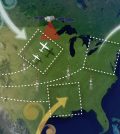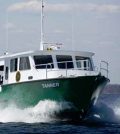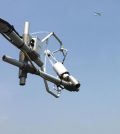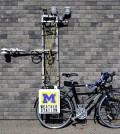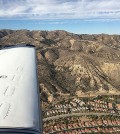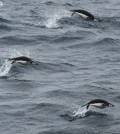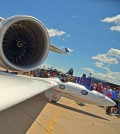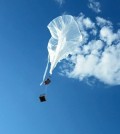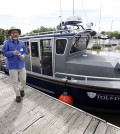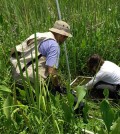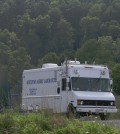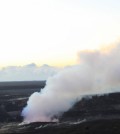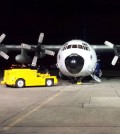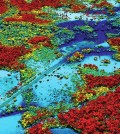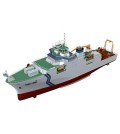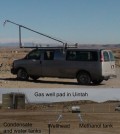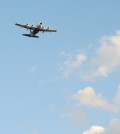Posts for tag "mobile research"
Weather Bikes Stand Out In Urban Studies, Advance Science Dialogue
Researchers using weather bikes tap into their potential for studying urban heat, air pollution and the effectiveness of green infrastructure.
- Posted November 3, 2016
US Research Flights Gauge Greenhouse Gases In Atmosphere
Penn State University scientists use research aircraft and air quality sensors to study greenhouse gases in several regions of the U.S.
- Posted August 4, 2016
R/V Tanner Launches On Lake Huron, Aids Fisheries Work
The Michigan Department of Natural Resources has launched a new research vessel to aid Lake Huron fisheries work, according to an article on the department’s website. The new ship, called R/V Tanner, replaces the R/V Chinook which...
- Posted July 8, 2016
Better Remote Air Quality Data With KORUS-AQ
An international team of scientists is conducting research flights across South Korea to assess air quality as part of the KORUS-AQ campaign.
- Posted June 9, 2016
Weather Bike Dissects Urban Heat Island Effect
A researcher at the University at Buffalo uses a bicycle-mounted weather station to study Cleveland’s urban heat island effect.
- Posted March 4, 2016
Measurements Reflect Scale Of Los Angeles’ Massive Methane Leak
During a massive methane leak that originated from a gas storage facility near Los Angeles, a scientist at the University of California, Davis made flights with a research aircraft to measure concentrations of the greenhouse gas. The...
- Posted February 17, 2016
ORCAS Campaign Studies Southern Ocean Carbon
An effort led by the National Center for Atmospheric Research will rely on research flights to dissect Southern Ocean carbon flux.
- Posted January 11, 2016
Perlan Glider Test Flight Launches Today Over Oregon
Today, a little before noon eastern standard time, the Perlan 2 glider will be towed to 5,000 feet and released over Redmond, Oregon for a test flight, according to a release. The Airbus Perlan Mission II team...
- Posted September 23, 2015
Malfunction Sends Montana Space Grant On Chase To Recover Lost Weather Balloon
After a test flight goes awry, Montana Space Grant scientists chase a weather balloon launched in Big Timber, Montana, to an island on Lake Winnipeg.
- Posted August 28, 2015
New University of Toledo Research Vessel Will Address Lake Erie Issues
The University of Toledo has dedicated a new research vessel for use by scientists and students studying Lake Erie issues, according to The Toledo Blade. These include efforts to fight invasive species and learn about the movement...
- Posted August 7, 2015
NASA Surveying Effort Tracks Gulf Coast’s Changing Wetlands
Using satellite technology and ground-based field work, NASA scientists finish a routine surveying effort of wetlands along the Gulf Coast.
- Posted July 29, 2015
Drexel Scientists Assess Air Quality Effects Of Extracting Marcellus Shale Gas
Scientists at Drexel University use a mobile air quality lab to assess methane and air pollutants around gas industry sites in northeast and southwest Pennsylvania.
- Posted June 11, 2015
MIT undergrads characterize Kīlauea’s volcanic smog
Undergraduate students at MIT use sulfur dioxide and aerosol measuring devices to characterize volcanic smog coming out of Hawaii’s Kīlauea volcano.
- Posted April 20, 2015
WINTER campaign captures cold’s effects on air pollution
Led by the University of Washington, a team of researchers combined expertise to study effects winter has on air pollution across the eastern U.S.
- Posted March 30, 2015
Train-mounted air quality sensors tracking Salt Lake Valley air pollution
Researchers at the University of Utah are working to measure air pollutants in the Salt Lake Valley, according to the Daily Utah Chronicle. But they’re doing it in a way few others have tried before, by strapping...
- Posted February 18, 2015
High-resolution airborne lab a leap for forest surveys
An ecologist at the Carnegie Institute for Science has developed one of the world’s most advanced airborne laboratories for studying forests, according to National Public Radio. Housed in an old German warplane, the lab provides fast and...
- Posted February 9, 2015
New South Korean research vessel to support institute’s sea floor focus
The South Korean ocean research program is expanding its capabilities, broadening its focus from sea floor minerals to seismology and more, Nature News reported. A new 5,900-ton research vessel is under construction to support the program’s shifting...
- Posted January 27, 2015
Indigo V research expedition proves potential for citizen-powered oceanography
Conducting a research expedition on a standard sailing yacht, scientists found that everyday sailors could perform marine monitoring with reduced expenses.
- Posted November 10, 2014
Instrumented quick-response van tracking oil, gas well emissions
A study led by the Cooperative Institute for Research in Environmental Sciences is one of the first to use quick-response instruments to track volatile organic compounds emitted from oil and gas wells, according to a release from...
- Posted November 6, 2014
FRAPPE air quality study investigates Front Range’s effect on Denver-area ozone
The Front Range Air Pollution and Photochemistry Experiment is studying ozone levels near Denver that have recently risen above air quality standards.
- Posted August 4, 2014



